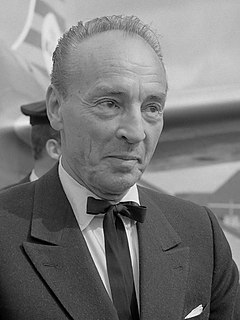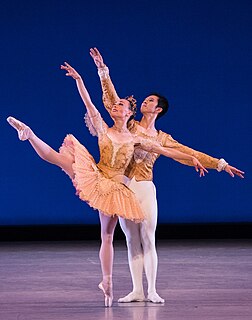Related Research Articles

George Balanchine was a Georgian-American ballet choreographer who was one of the most influential 20th-century choreographers. Styled as the father of American ballet, he co-founded the New York City Ballet and remained its Artistic Director for more than 35 years. His choreography is characterized by plotless ballets with minimal costume and décor, performed to classical and neoclassical music.

Bronislava Nijinska was a Polish ballet dancer, and an innovative choreographer. She came of age in a family of traveling, professional dancers.

Tamara Toumanova was a Georgian-American prima ballerina and actress. A child of exiles in Paris after the Russian Revolution of 1917, she made her debut at the age of 10 at the children's ballet of the Paris Opera.

Frederic Franklin, sometimes also called "Freddie", was a British-American ballet dancer, choreographer and director.

Leonid Fyodorovich Myasin, better known in the West by the French transliteration as Léonide Massine, was a Russian choreographer and ballet dancer. Massine created the world's first symphonic ballet, Les Présages, and many others in the same vein. Besides his "symphonic ballets," Massine choreographed many other popular works during his long career, some of which were serious and dramatic, and others lighthearted and romantic. He created some of his most famous roles in his own comic works, among them the Can-Can Dancer in La Boutique fantasque (1919), the Hussar in Le Beau Danube (1924), and, perhaps best known of all, the Peruvian in Gaîté Parisienne (1938). Today his oeuvre is represented by his son Theodor Massine.

Tatiana Mikhailovna Riabouchinska was a Russian American prima ballerina and teacher. Famous at age 14 as one of the three "Baby Ballerinas" of the Ballet Russe de Monte Carlo in the 1930s, she matured into an artist whom critics called "the most unusual dancer of her generation."

The Seven Deadly Sins is a satirical ballet chanté in seven scenes composed by Kurt Weill to a German libretto by Bertolt Brecht in 1933 under a commission from Boris Kochno and Edward James. It was translated into English by W. H. Auden and Chester Kallman and more recently by Michael Feingold. It was the last major collaboration between Weill and Brecht.
David Lichine was a Russian-American ballet dancer and choreographer. He had an international career as a performer, ballet master, and choreographer, staging works for many ballet companies and for several Hollywood film studios.

The Ballets Russes was an itinerant ballet company based in Paris that performed between 1909 and 1929 throughout Europe and on tours to North and South America. The company never performed in Russia, where the Revolution disrupted society. After its initial Paris season, the company had no formal ties there.

Boris Evgenievich Kochno or Kokhno was a Russian poet, dancer and librettist.
Baby ballerinas is a term invented by the English writer and dance critic Arnold Haskell to describe three young dancers of the Ballets Russes de Monte-Carlo in the early 1930s: Irina Baronova (1919–2008), Tamara Toumanova (1919–1996), and Tatiana Riabouchinska (1917–2000).

The company Ballets Russes de Monte-Carlo was formed in 1932 after the death of Sergei Diaghilev and the demise of Ballets Russes. Its director was Wassily de Basil, and its artistic director was René Blum. They fell out in 1936 and the company split. The part which de Basil retained went through two name changes before becoming the Original Ballet Russe. Blum founded Les Ballets de Monte Carlo, which changed its name to Ballet Russe de Monte-Carlo when Léonide Massine became artistic director in 1938. It operated under this name until it disbanded some 20 years later.

Ottilie Ethel Leopoldine Herbert, Countess of Carnarvon, known professionally as Tilly Losch, was an Austrian dancer, choreographer, actress, and painter who lived and worked for most of her life in the United States and United Kingdom.
John Taras was an American ballet master, repetiteur, and choreographer.

Theme and Variations is a ballet choreographed by George Balanchine to the final movement of Tchaikovsky's Orchestral Suite No. 3. The ballet was made for Ballet Theatre, and premiered on November 26, 1947, at the City Center 55 Street Theater, with the two leads danced by Alicia Alonso and Igor Youskevitch.
Le Bourgeois Gentilhomme refers to two different ballets by George Balanchine set to Richard Strauss's Concert Suite (1917), with a libretto after Molière's 17th-century comédie-ballet of the same name.
The Original Ballet Russe was a ballet company established in 1931 by René Blum and Colonel Wassily de Basil as a successor to the Ballets Russes, founded in 1909 by Sergei Diaghilev. The company assumed the new name Original Ballet Russe after a split between de Basil and Blum. De Basil led the renamed company, while Blum and others founded a new company under the name Ballet Russe de Monte-Carlo. It was a large scale professional ballet company which toured extensively in Europe, Australia and New Zealand, the United States, and Central and South America. It closed down operations in 1947.
Mozartiana is a ballet by New York City Ballet co-founder and balletmaster George Balanchine which opened their Tschaikovsky Festival. It is the choreographer's third homage to Mozart and is set to Pyotr Ilyich Tchaikovsky's Suite No. 4, Mozartiana, Op. 61 (1887), consisting of:

Tamara Tchinarova, also known as Tamara Finch, was a Romanian-born émigré Russian and French ballerina who contributed significantly to the development of Australian dance companies and was a Russian/English interpreter for touring ballet companies. She was a dance writer and author, as Tamara Finch, of a number of non-fiction books. She was the first wife of actor Peter Finch.
Marie-Jeanne Godwin was an American ballet dancer. She was one of the first students of George Balanchine's School of American Ballet. Her dance career started at the Ballet Caravan in 1937, followed by stints at Ballet Russe de Monte Carlo, American Ballet Caravan, Ballet International and Ballet Society, before becoming a founding member of the New York City Ballet, where she danced for one season. She then joined Grand Ballet du Marquis de Cuevas, before briefly returning to the New York City Ballet in 1953, and retired in 1954. She was associated with Balanchine throughout her career.
References
- ↑ "Oxford Dictionary of Dance: Les Ballets 1933." Answers.com. N.p., n.d. Web. 15 July 2013.
- 1 2 3 Reynolds, Nancy. "Ballets 1933." The International Encyclopedia of Dance. Ed. Selma J. Cohen. Oxford University Press, 2005. Wollman Library, Barnard College. Web. 11 July 2013.
- ↑ Homans, Jennifer. "René Blum: Life of a Dance Master," New York Times (July 8, 2011).
- ↑ "Tilly Losch - Person - National Portrait Gallery". www.npg.org.uk. Retrieved December 27, 2017.
- ↑ Buckle, Richard; and John Taras. George Balanchine Ballet Master. New York: Random House, 1988. Print.
- ↑ Sydney Morning Herald, "She chose to be a great fiddler’s moll"
- ↑ Taper, Bernard. Balanchine: a Biography (University of California Press, 1996), p. 142.
- 1 2 3 Menuhin, Diana. "Dance Research: The Journal of the Society for Dance Research." jstor.org. N.p., n.d. Web. 15 July 2013.
- ↑ Kisselgoff, Anna. "DANCE VIEW; Taking Fresh Stock of Les Ballets 1933," New York Times (August 19, 1990).
- ↑ Taper, pp. 421-422.